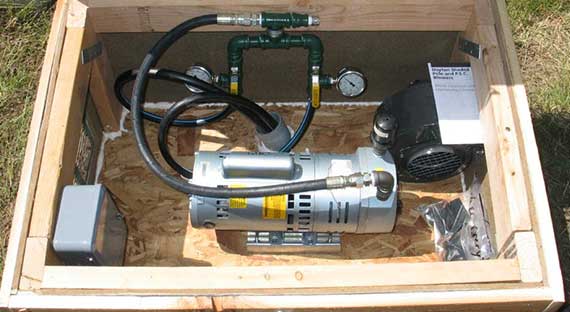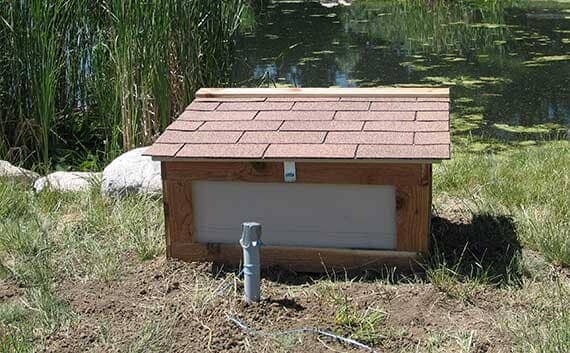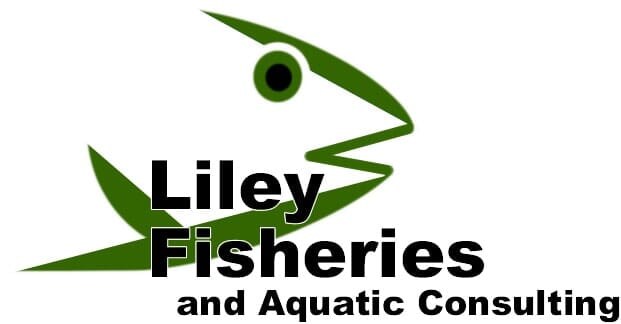Lake and Pond Aeration in Colorado and Wyoming
The most important function lakebed aeration serves is to provide oxygen to the bottom of the lake where organic nutrients and sediments accumulate.
The source of these nutrient and sediment inputs include decaying leaf matter, decaying aquatic vegetation, fish feces, waterfowl feces, storm runoff, and nutrients from irrigated lawn areas surrounding the lake.
Without aeration, these nutrient-rich sediments accumulate on the bottom in a low or no oxygen environment and are subject only to anaerobic microbial decomposition. Anaerobic decomposition is a very slow and ineffective process and one of the primary byproducts of this process is hydrogen sulfide which results in a rotten egg odor. Anaerobic conditions at the bottom of a lake also result in the release of these nutrients from the sediments where they are readily available as the primary food source for algae (moss) and other aquatic vegetations.
The source of these nutrient and sediment inputs include decaying leaf matter, decaying aquatic vegetation, fish feces, waterfowl feces, storm runoff, and nutrients from irrigated lawn areas surrounding the lake.
Without aeration, these nutrient-rich sediments accumulate on the bottom in a low or no oxygen environment and are subject only to anaerobic microbial decomposition. Anaerobic decomposition is a very slow and ineffective process and one of the primary byproducts of this process is hydrogen sulfide which results in a rotten egg odor. Anaerobic conditions at the bottom of a lake also result in the release of these nutrients from the sediments where they are readily available as the primary food source for algae (moss) and other aquatic vegetations.
Providing oxygen to the bottom of the lake allows for aerobic microbial activity which is more effective at decomposing sediments and nutrient, as well as keeping the nutrients entrained in the sediments thus reducing their availability for aquatic plant utilization.
Another benefit of a low-velocity lakebed aeration system is to provide a well-oxygenated environment at greater water depths for utilization by the fish in the lake or pond.
Without aeration, most deep lakes thermally stratify during summer and winter months creating a layer of warmer water over a layer of cooler weather in the summer, and vice versa in the winter, leading to a condition where only the top layer of water is adequately oxygenated and suitable for fish use. The cycle of stratification can be broken by mixing the lake water from the bottom to the top with low-velocity aeration. This mixing creates a more uniform temperature in the lake and provides oxygenation to all layers in the water column.
Another benefit of a low-velocity lakebed aeration system is to provide a well-oxygenated environment at greater water depths for utilization by the fish in the lake or pond.
Without aeration, most deep lakes thermally stratify during summer and winter months creating a layer of warmer water over a layer of cooler weather in the summer, and vice versa in the winter, leading to a condition where only the top layer of water is adequately oxygenated and suitable for fish use. The cycle of stratification can be broken by mixing the lake water from the bottom to the top with low-velocity aeration. This mixing creates a more uniform temperature in the lake and provides oxygenation to all layers in the water column.
Design
LFI designs aeration systems specific to the environmental conditions/issues of your aquatic resource. Every aquatic ecosystem is different and therefore each solution is different.
Typically LFI Biologists go onsite and collect data (identify aquatic vegetation and abundance, define the total surface area, average depth, total sediment accrual and dissolved oxygen levels) to determine if the resource needs aeration, and if so, what system.
Analysis of the data allows us to design an aeration system that meets the unique needs of your aquatic resource.
Typically LFI Biologists go onsite and collect data (identify aquatic vegetation and abundance, define the total surface area, average depth, total sediment accrual and dissolved oxygen levels) to determine if the resource needs aeration, and if so, what system.
Analysis of the data allows us to design an aeration system that meets the unique needs of your aquatic resource.

A typical aeration system includes:
- Aeration shed
- Exhaust Fan
- 24 Hour Time Clock
- Piston or Rotary Vein Air Compressor(s)
- Tubular Diffuser(s) with Galvanized Frame
- Air Distribution Manifold with Gauges and Valves
- High-Temperature Hose Assembly
- Air Flex Feeder Tubing
- L5 Weighted Aeration Tubing
- One year manufacturers warranty on compressors, exhaust fans, and time clocks (does not include labor to remove or replace parts or shipping costs to/from manufacturer)
- Two-year parts and labor warranty on lakebed components
- Electrical hookup of unit is not included
Installation
LFI aeration technicians are available to install aeration systems purchased from us at your request. All components will be strategically installed to maximize the effectiveness, efficiency, and aesthetics of your aeration system.



